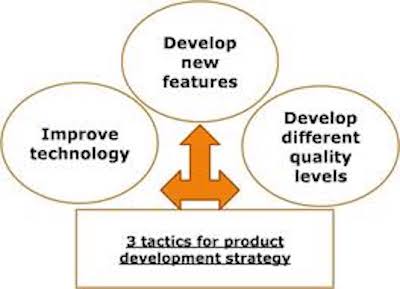In case you are wondering about what a product development strategy is, then let us clarify that for you immediately.
Simply put, a product development strategy provides a series of guidelines for creating new products or improving the performance, cost or quality of existing products.

Ultimately, when a company decides to use the product development strategy, it is doing so to meet its business goals. These may be winning business from competitors, selling more to existing customers, or even entering new markets.
A successful product development strategy can also increase revenue and profitability, but careful planning is essential to minimize the risk of costly mistakes.
The truth is that many new products that are launched to the market fail. This is why the product development strategy is considered high-risk. So, to ensure that you minimize it, you need to ensure that you set measurable goals and review progress at each stage of development, from generating ideas, through technical and commercial assessment to detailed development and launch.
So, to achieve success, you should focus on developments that meet genuine customer needs, rather than developing exciting technical features that customers do not need.
Discover more benefits of product development.

By improving the performance of existing products, you can help your sales team win business from competitors that cannot match the new level of performance. Improved performance also enables you to increase revenue or profit by charging higher prices for a superior product.
There’s no question that most businesses are always looking to be recognized as the best ones in their field. But if there is a field where you want to gain this kind of reputation is quality.
So, with this in mind, you should set targets for quality improvement in your product development program which will help you increase sales. If you deal with companies that impose their own quality standards as a condition of purchasing, you can ensure that you qualify as an approved supplier by making necessary improvements. You may introduce materials that are more reliable or redesign the product to meet the customer’s quality specifications. Quality improvements may also help you enter markets where suppliers must meet regulatory requirements.
Learn more about the product development strategy.

Cost reduction is always a very important goal in product development. After all, lower costs give you the flexibility to lower your prices and win new business or maintain prices and increase your profit margin. Product development teams can reduce costs by using lower-cost materials, eliminating features that the market does not need or redesigning the product to simplify the manufacturing process.
Take a look at the benefits of new product development.

A product development strategy can fail to deliver its benefits at different stages in the process. When the team is generating ideas, it may not carry out enough research into market requirements, leading to developments that do not meet customer needs. During the technical assessment stages, the team must ensure that the company can turn the idea into a finished product with available technology and manufacturing resources.
It also must carry out a commercial assessment to ensure that the project can generate sufficient profitable revenue to cover development, manufacturing and marketing costs. Testing the product in the market before launch can also reduce risk. By asking a selection of customers for feedback on a prototype, you can fine-tune the production version in line with market requirements.